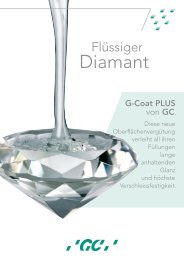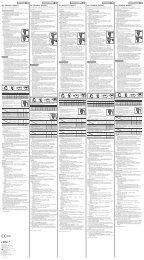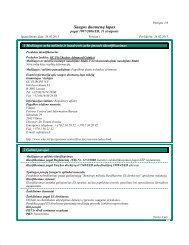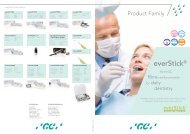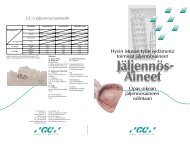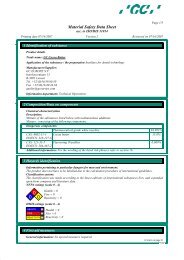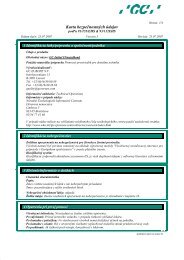Leaflet Full Version - GC Europe
Leaflet Full Version - GC Europe
Leaflet Full Version - GC Europe
- TAGS
- leaflet
- www.gceurope.com
Create successful ePaper yourself
Turn your PDF publications into a flip-book with our unique Google optimized e-Paper software.
<strong>GC</strong> GRADIA DIRECT<br />
Light - Cured Composite Restorative<br />
One -shade simplicity<br />
and aesthetic invisibility
<strong>GC</strong> Gradia Direct<br />
has been rated<br />
excellent with 5<br />
scores out of 5 by<br />
The Dental Advisor<br />
(vol.21 -2004).<br />
The excellent aesthetics achievable with<br />
<strong>GC</strong> Gradia Direct, its ability to blend with<br />
surrounding tooth structure, outstanding<br />
handling properties without stickiness and<br />
the simplicity of the shade system, were all<br />
high-lighted by the journal ’s Editor.<br />
Around 95% of direct restoration<br />
procedures use only one shade of<br />
restorative, mainly as its faster and<br />
easier, so minimising chair-side time.<br />
The move towards minimum<br />
intervention dentistry also means<br />
that more of these procedures are<br />
being carried out as often this is the<br />
best way of preserving tooth<br />
structure. Unfortunately, with a<br />
single shade current products tend<br />
to give a rather poor aesthetic<br />
match to surrounding tooth<br />
<strong>GC</strong> GRADIA DIRECT<br />
Light - Cured Composite Restorative<br />
The Reality Product<br />
Guide has also awarded<br />
<strong>GC</strong> Gradia Direct 4 stars<br />
noting in particular its easy<br />
handling properties.<br />
One shade of <strong>GC</strong> GRADIA DIRECT gives<br />
brilliant aesthetic ‘invisibility’<br />
structure. A better match can be<br />
achieved by adding further shades,<br />
but this is rarely employed as the<br />
whole procedure becomes far more<br />
complex and time-consuming.<br />
Current products therefore, do not<br />
suit today’s way of working.<br />
A compromise often has to<br />
be made between aesthetics<br />
and simplicity.<br />
Now, you can achieve brilliant<br />
aesthetics with one shade, by using<br />
GRADIA DIRECT from <strong>GC</strong>.<br />
Developed as part of <strong>GC</strong>'s<br />
commitment to minimum<br />
intervention dentistry and based on<br />
<strong>GC</strong> GRADIA, our laboratory system<br />
for making high-end aesthetic<br />
crown and bridge work,<br />
<strong>GC</strong> GRADIA DIRECT is a<br />
composite with a unique particle<br />
structure and a clever yet simple<br />
shade system. Available in Anterior<br />
and Posterior versions <strong>GC</strong> GRADIA<br />
DIRECT sets a new standard for<br />
aesthetic 'invisibility' and ease of<br />
use, giving a superb, naturallooking<br />
restoration with only one<br />
shade and if further aesthetic<br />
enrichment is required, extra<br />
shades can be added very simply.<br />
one-shade<br />
simplicity<br />
and aesthetic<br />
‘invisibility’<br />
without<br />
compromise<br />
2 3
One shade with<br />
an ordinary product<br />
often gives a poor<br />
chameleon effect<br />
Perfect translucency and opalescence<br />
The ability of a restoration to<br />
match the appearance of<br />
surrounding tooth is called the<br />
chameleon effect. The better the<br />
effect, the less visible the restoration.<br />
To enable close matching to the<br />
natural tooth, direct restoratives<br />
come in a range of shades, each<br />
delicately balancing the threedimensional<br />
components of colour,<br />
namely:<br />
• hue - the pure colour itself<br />
• chroma - the saturation of the colour<br />
• value - the lightness or darkness of<br />
the colour<br />
The better the chameleon effect, the better the match to surrounding tooth<br />
The nature of tooth structure also<br />
brings into play other optical<br />
properties which influence their<br />
appearance, so the restorative<br />
material has to try and mimic these<br />
properties too:<br />
• translucency - parts of the<br />
tooth structure are translucent so<br />
some light passes through, whilst<br />
other parts are opaque so no light<br />
goes through<br />
• opalescence - some structures<br />
within a tooth such as the enamel<br />
layer, produce shimmering pale<br />
colours<br />
• fluorescence - is the ability of teeth<br />
to absorb UV wavelengths and<br />
emit visible, mostly bluish light<br />
However, experience with the<br />
current ordinary restoratives shows<br />
that when one shade is used the<br />
chameleon effect produced is often<br />
not that good. To achieve a better<br />
effect and so more acceptable<br />
aesthetics, further shades need<br />
to be added.<br />
One shade of<br />
<strong>GC</strong> GRADIA DIRECT<br />
gives more<br />
than a good<br />
chameleon effect<br />
- it’s an invizi-fx<br />
The chameleon effect<br />
achievable with one shade of<br />
<strong>GC</strong> GRADIA DIRECT is so good that<br />
the restoration does more than just<br />
‘match’ the surrounding natural<br />
tooth - it becomes aesthetically<br />
‘invisible’. In fact, we call it the<br />
invizi-fx. One of the main reasons<br />
why <strong>GC</strong> GRADIA DIRECT can do<br />
this is because it has a more diverse<br />
structural composition than other<br />
direct restoratives, which better<br />
reproduces the reflectivity of a<br />
natural tooth.<br />
<strong>GC</strong> GRADIA DIRECT gives more than a good chameleon effect - it's an invizi-fx<br />
BEFORE RESTORATION AFTER RESTORATION<br />
<strong>GC</strong> GRADIA DIRECT<br />
is more aesthetically<br />
‘invisible’ as it more<br />
accurately copies<br />
the reflectivity of a<br />
natural tooth<br />
4 5
6<br />
Reflection<br />
determines colour<br />
perception<br />
The way a natural tooth reflects<br />
light determines its perceived<br />
colour. When all wavelengths are<br />
reflected, which occurs on the<br />
outside of a highly polished tooth,<br />
it is called mirror reflection.<br />
This produces the tooth's<br />
glossy appearance.<br />
The process of reflection from<br />
inside a natural tooth is<br />
determined by its diverse<br />
multifaceted structures, such as the<br />
enamel crystals, dentinal tubules,<br />
the peritubular dentin and the<br />
dentine/enamel junction, all of<br />
which together create a complex<br />
series of reflective interfaces.<br />
However, only certain wavelengths<br />
are reflected as some of the light is<br />
absorbed. This type of reflection is<br />
called diffuse reflection and it is<br />
responsible for how the tooth's hue,<br />
chroma and value are actually<br />
perceived as well as its translucency<br />
and opalescence. The tooth's<br />
fluorescent appearance comes from<br />
emitted light.<br />
The reason why a <strong>GC</strong> GRADIA<br />
DIRECT restoration produces such a<br />
good invizi-fx is that, like tooth<br />
structure, it too is made up of diverse<br />
multifaceted structures - a variety of<br />
particles consisting of a micro-filled<br />
matrix of resin composite, with<br />
compounds mainly of silica and<br />
pre-polymerised fillers.<br />
The amount of each constituent<br />
and its particle size distribution has<br />
been carefully chosen so that when<br />
added together, many different<br />
interfaces occur with different<br />
reflective properties. The result is<br />
an internal reflectivity which more<br />
accurately reproduces that of<br />
natural tooth.<br />
Natural<br />
reflectivity means<br />
natural aesthetics<br />
<strong>GC</strong> GRADIA DIRECT has a diverse particle<br />
structure (x 10,000)<br />
Ordinary restoratives have a simpler particle<br />
structure (x 10,000)<br />
Absorption Absorption<br />
NATURAL TOOTH <strong>GC</strong> GRADIA DIRECT RESTORATION<br />
Emission Emission<br />
Fluorescence<br />
Diffuse Reflection<br />
Diffuse Reflection<br />
Diffuse Reflection<br />
Diffuse Reflection<br />
Particle structure<br />
mimics reflectivity of<br />
natural tooth<br />
Hue<br />
Chroma<br />
Value<br />
Translucency<br />
Opalescence<br />
Mirror Reflection Glossy Sheen<br />
The tooth-like reflectivity of<br />
<strong>GC</strong> GRADIA DIRECT means that<br />
its hue, chroma, value,<br />
translucency, opalescence and<br />
fluorescence is perceived as far<br />
more natural and life-like.<br />
The overall effect, or invizi-fx,<br />
is that a <strong>GC</strong> GRADIA DIRECT<br />
restoration is more aesthetically<br />
'invisible' with a single shade and<br />
gives outstanding high-end<br />
aesthetics when further shades<br />
are used.<br />
Diffuse Reflection<br />
Diffuse Reflection<br />
Diffuse Reflection<br />
Diffuse Reflection<br />
Mirror Reflection<br />
In contrast, current direct<br />
restoratives do not have such a<br />
diversity of multifaceted particles and<br />
so just one shade has a more limited<br />
reflectivity and poorer aesthetics.<br />
The only way further multireflections<br />
can be created to improve<br />
appearance is to add more layers.<br />
Internal structure of restoration with <strong>GC</strong> GRADIA DIRECT<br />
<strong>GC</strong> GRADIA DIRECT<br />
has a similar diverse<br />
multifaceted structure<br />
to that of NATURAL<br />
TOOTH. Their<br />
reflectivity and so<br />
optical properties are<br />
therefore very similar,<br />
making the restoration<br />
aesthetically 'invisible'<br />
- the invizi-fx.<br />
7
Unique Shade<br />
System for even<br />
greater simplicity<br />
To contribute effectively to the<br />
overall 'invisibility' of a restoration,<br />
the invizi-fx must work in<br />
combination with the correct shade<br />
or shades of <strong>GC</strong> GRADIA DIRECT.<br />
To help choose the right hue,<br />
chroma, value and translucency,<br />
there is a clever yet remarkably<br />
simple Shade System with Shade<br />
Guide designed for both the singleshade<br />
and multi-shade techniques.<br />
Standard Shades<br />
For the single-shade technique,<br />
using just one of the Standard<br />
Shades gives an excellent result.<br />
Available in both the Anterior and<br />
Posterior versions, each is a delicate<br />
balance between hue, chroma,<br />
value and translucency. The Anterior<br />
version has A, B and C shade groups<br />
which are based on the VITAPAN<br />
Classical ® Shade Guide, as well as<br />
CV (Cervical), BW (Bleach White)<br />
and XBW (Extra Bleach White). The<br />
Posterior version has A shades only.<br />
Example of anterior restoration<br />
Example of posterior restoration<br />
Special Shades<br />
Although <strong>GC</strong> GRADIA DIRECT<br />
gives excellent aesthetics for the<br />
95% of procedures that use just a<br />
single shade, there maybe times<br />
when the multi-shade technique is<br />
preferred such as when extensive<br />
restoration is required. There are<br />
two types of additional shades to<br />
choose from, called Special Shades<br />
which are placed underneath or on<br />
top of a Standard Shade.<br />
Inside Special Shades<br />
These are opaque shades which<br />
are placed underneath a Standard<br />
Shade to give warmth to the final<br />
colour and block out 'dark shine'<br />
through the mouth. Available only<br />
in the Anterior version there are<br />
three Inside Special Shades: AO2,<br />
AO3 and AO4.<br />
Example of anterior restoration<br />
Example of posterior restoration<br />
Outside Special Shades<br />
Placed on top of a Standard Shade<br />
these shades take account of agerelated<br />
changes in the enamel which<br />
affect its translucency and value. This<br />
gives a more lifelike appearance.<br />
As the enamel width goes from<br />
thick to thin with age its value<br />
reduces. For a child the WT shade<br />
(White Translucent) gives the most<br />
Anterior 22 shades<br />
AO2 AO3 AO4<br />
DT CT GT NT WT CVT<br />
Posterior 6 shades<br />
white, and the DT shade (Dark<br />
Translucent) is for darker adult teeth.<br />
For the elderly there is the GT shade<br />
(Grey Translucent) which gives the<br />
most black value and the CVT shade<br />
(Cervical Translucent) is for the<br />
cervical area.<br />
When the enamel gets thinner the<br />
tooth's translucency increases. This<br />
is particularly noticeable at the<br />
8 9<br />
Standard<br />
Inside<br />
Special<br />
Outside<br />
Special<br />
Standard<br />
Outside<br />
Special<br />
XBW BW A1 A2 A3 A3,5 A4 B1 B2 B3 C3 CV CVD<br />
P-A1 P-A2<br />
P-WT P-NT<br />
P-A3 P-A3,5<br />
Shade Guide<br />
Most shades are linked to the<br />
VITAPAN Classical ® Shade Guide but<br />
some are unique, so to aid selection<br />
there is a simple to use Shade Guide.<br />
This has wedge shaped 'fingers' of<br />
increasing thickness to help dentists<br />
judge the influence of material<br />
thickness on a particular shade.<br />
incisal edges. To better match the<br />
present translucency the CT shade<br />
(Clear Translucent) can be used<br />
and/or the NT shade (Natural<br />
Translucent).<br />
All Outside Special Shades are<br />
available in the Anterior version and<br />
for the Posterior version there are<br />
the WT and NT shades.<br />
XBW: Extra Bleach White<br />
BW: Bleach White<br />
CV: Cervical<br />
CVD: Cervical Dark<br />
DT: Dark Translucent<br />
CT: Clear Translucent<br />
GT: Grey Translucent<br />
NT: Natural Translucent<br />
WT: White Translucent<br />
CVT: Cervical Translucent<br />
Standard and Inside Special<br />
shades are based on the<br />
Vita ® Shade Guide.
All the properties<br />
required for superb,<br />
long-lasting<br />
restorations<br />
Good polishability<br />
For improved aesthetics,<br />
<strong>GC</strong> GRADIA DIRECT polishes<br />
quickly and easily to a smooth,<br />
glossy surface.<br />
Tough and flexible<br />
To resist bending and occlusal<br />
forces as well as the spread of<br />
cracks, <strong>GC</strong> GRADIA DIRECT has<br />
high fracture toughness and a low<br />
modulus of elasticity.<br />
High wear resistance<br />
Essential for posterior restorations,<br />
<strong>GC</strong> GRADIA DIRECT is very<br />
durable, resisting occlusal wear<br />
exceptionally well yet has low wear<br />
on opposing dentition.<br />
Light curable<br />
<strong>GC</strong> GRADIA DIRECT can be light<br />
cured using a quartz halogen,<br />
plasma arc or LED light. There is<br />
minimum colour change before<br />
and after light curing.<br />
Radiopaque<br />
The posterior version of<br />
<strong>GC</strong> GRADIA DIRECT<br />
is radiopaque.<br />
<strong>GC</strong> GRADIA DIRECT<br />
A complete<br />
system for direct<br />
restorations<br />
<strong>GC</strong> GRADIA DIRECT Anterior<br />
Class III, IV and V cavities<br />
Wedge-shaped defects and root<br />
surface cavities<br />
Veneers and diastema closure<br />
<strong>GC</strong> GRADIA DIRECT Posterior<br />
Class I and II cavities<br />
When radiopacity is required<br />
<strong>GC</strong> G-Bond<br />
A single component bonding system<br />
which bonds <strong>GC</strong> GRADIA DIRECT to<br />
tooth structure in one coat, for a fast<br />
and easy application. The unique<br />
combination of phosphoric ester<br />
monomer and 4-MET adhesive<br />
technology gives superior etch and<br />
adhesion to enamel, in addition to an<br />
excellent chemical and mechanical<br />
seal to dentin.<br />
<strong>GC</strong> Gradia Direct Flo<br />
Specially designed for lining cavities<br />
beneath <strong>GC</strong> GRADIA DIRECT,<br />
<strong>GC</strong> Gradia Direct Flo is a micro-filled<br />
hybrid resin which is radiopaque and<br />
light-curable. It has an easy to use<br />
free-flowing, no-run/no-stick formula<br />
that shapes perfectly to cavity walls.<br />
To view in detail the remarkable<br />
capabilities of <strong>GC</strong> GRADIA DIRECT,<br />
a Clinical Manual is available on<br />
request, which shows a range of<br />
actual case studies.<br />
Packaging<br />
<strong>GC</strong> GRADIA DIRECT<br />
SHADES ANTERIOR:<br />
Standard: A1, A2, A3, A3.5, A4, B1, B2,<br />
B3, C3, CV, CVD, BW, XBW<br />
Inside Special: AO2, AO3, AO4<br />
Outside Special: NT, CT, DT, WT,<br />
GT, CVT<br />
SHADES POSTERIOR:<br />
Standard: P-A1, P-A2, P-A3, P-A3.5<br />
Outside Special: P-WT, P-NT<br />
<strong>GC</strong> G-Bond<br />
<strong>GC</strong> Gradia Direct Flo<br />
10 11<br />
PACKAGES<br />
UNITIPS<br />
Complete kit: All available Standard,<br />
Inside Special and Outside Special<br />
shades, except for B1 and XBW, and<br />
a shade guide<br />
Introductory kit: 5 Unitips each of<br />
A2, A3, A3.5, AO3, CV, CT and P-A2,<br />
and a Shade Guide<br />
Refill: 20 Unitips of: A1, A2, A3, A3.5,<br />
AO3, CV, DT, NT, P-A1, P-A2, P-A3,<br />
P-A3.5, P-WT, P-NT<br />
10 Unitips of: A4, B1, B2, B3, C3, AO2,<br />
AO4, CVD, BW, XBW, CT, WT, GT, CVT<br />
Note:<br />
Content per unitip: 0.16ml (0.24g) for anterior<br />
and 0.16ml (0.28g) for posterior.<br />
Content per syringe: 2.7ml (4g) for anterior<br />
and 2.7ml (4.7g) for posterior.<br />
PACKAGES<br />
Starter Kit Bottle:<br />
5 ml bottle, 50 micro-tip applicators,<br />
1micro-tip applier, 1 dispenser tray<br />
Starter Kit Unit Doses:<br />
50 x 0.1 ml unit doses, 50 green<br />
disposable applicators<br />
PACKAGES<br />
Refill: 2 x 1.5 g / 0.8 ml syringes,<br />
4 dispensing tips needle type and<br />
2 light protective covers<br />
Shade: A3<br />
Accessories:<br />
Gradia Direct Flo Dispensing Tips,<br />
Needle Type, 20 pcs<br />
Gradia Direct Flo Dispensing Tips,<br />
Plastic Type, 20 pcs<br />
Accessories:<br />
Unitip Applier, Shade Guide<br />
SYRINGES<br />
Complete kit: 26 syringes of all<br />
available Standard, Inside Special<br />
and Outside Special shades, except<br />
for B1 and XBW, and a shade guide<br />
Introductory kit: 7 Syringes of:<br />
A2, A3, A3.5, AO3, CV, CT, P-A2<br />
and a Shade Guide<br />
Refill: 1 Syringe of the available<br />
colours<br />
The VITAPAN Classical ® Shade Guide<br />
and Vita ® are registered trademarks of<br />
Vita Zahnfabrik, Bad Säckingen, Germany.
<strong>GC</strong> EUROPE N.V. <strong>GC</strong> UNITED KINGDOM Ltd.<br />
Head Office 22-23, Coopers Court<br />
Interleuvenlaan 13 Newport Pagnell<br />
B - 3001 Leuven UK - Bucks. MK16 8JS<br />
Tel. +32.16.39.80.50 Tel. +44.1908.218.999<br />
Fax. +32.16.40.02.14 Fax. +44.1908.218.900<br />
E-mail info@gceurope.com E-mail info@uk.gceurope.com<br />
www.gceurope.com www.uk.gceurope.com<br />
z O LF GB 8 47 04/05



